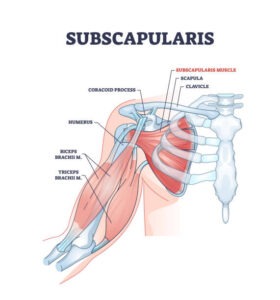Subscapularis Tendon Strain
If you are experiencing a subscapularis tendon strain please Schedule an appointment with one of our orthopedic surgeons as soon as possible.
What is a Subscapularis Tendon Strain

The subscapularis is a vital muscle located in the front of the shoulder, forming part of the rotator cuff. It plays a key role in rotating the arm inward (internal rotation) and stabilizing the shoulder joint. A subscapularis tendon strain occurs when the tendon attaching this muscle to the upper arm bone is overstretched or torn. This type of injury can lead to significant shoulder pain, weakness, and limited range of motion, especially during activities involving lifting, reaching, or overhead motion.
What Causes a Subscapularis Tendon Strain?
Subscapularis tendon strains typically result from:
-
Repetitive shoulder movements – Common in athletes who throw, swim, or lift weights, as well as in jobs that require frequent overhead lifting.
-
Trauma or sudden force – A fall on an outstretched arm or lifting a heavy object with improper technique can cause a strain or tear.
-
Degenerative changes – Over time, the tendon may weaken due to aging or chronic overuse, making it more prone to injury.
-
Poor posture and biomechanics – Imbalances in shoulder mechanics can place added stress on the subscapularis tendon.
Symptoms of a Subscapularis Tendon Strain
Injuries to the subscapularis tendon can vary in severity, but typical symptoms include:
-
Pain in the front of the shoulder, especially during internal rotation or lifting
-
Weakness when rotating the arm inward
-
Difficulty reaching behind the back or tucking in a shirt
-
Tenderness at the front of the shoulder
-
Clicking or catching sensations with movement
-
Swelling or visible muscle imbalance in more severe cases
If you experience these symptoms, especially after a shoulder injury or strenuous activity, it’s important to seek professional evaluation.
Diagnosing Subscapularis Strain
Specific strength tests and range-of-motion assessments help identify the extent of the injury. Imaging studies such as MRI or ultrasound may be recommended to confirm the diagnosis and rule out a complete tear or additional rotator cuff damage.
Treatment and Recovery
Treatment depends on the severity of the strain. Most mild to moderate cases respond well to conservative care:
-
Rest and activity modification to prevent further strain
-
Physical therapy to restore strength, flexibility, and proper shoulder mechanics
-
Anti-inflammatory medications to reduce pain and swelling
-
Ice or heat therapy depending on the stage of healing
For more severe or complete tears, especially if function is significantly impaired, surgical repair may be considered.

